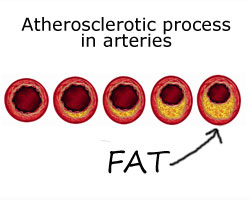Obesity and Heart Disease

It cannot be stressed enough how important being slim is in order to have a healthy heart and to live a longer, more fulfilling life. In the past, the main cause of death was disease and starvation. Now the tables have turned and the main killer is the obesity.
The percentage of people that suffer from obesity is growing with each passing year. In this article we would like to tell you about this serious problem and address the following issues:
- Why are we, as a nation, getting fatter?
- How does obesity affect the heart?
Why are we getting fatter?

You might think that this is a simple question with a simple answer, the answer being: “Because we eat too much!” However, in reality, it is much more complicated.
The number of people suffering from obesity is steadily growing with each passing year. Today, it is even labeled an epidemic, with as many as 70% of Americans being either overweight or obese.
There are a multitude of factors that play a role in this epidemic. However, the most important factor contributing to the obesity epidemic in developed countries is high fructose consumption.
Use of high fructose corn syrup as an artificial sweetener
Few people realize it, but over the past few decades, the manufacturers have shifted from using regular sugar to using High Fructose Corn Syrup. This type of sweetener is much cheaper than regular sugar and manufacturers decided it would be more profitable to use this product. At the same time, the average consumer, if he bothered to look at the label, probably thinks fructose must be even better than sugar since it from fruits, and fruits are healthy. Right?
Well, it appears that this type of logic doesn’t apply in this case. The fact is, all the fructose that is now used in soft drinks, breads, cereals, lunch meats, breakfast bars, soups and yogurts is actually very detrimental to your health.
Over the past years, a large number of studies have been published highlighting the adverse effects of high amounts of fructose on the human body. For example, in a report published in 2002 in The American Journal of Clinical Nutrition, named “Fructose, Weight Gain, and the Insulin Resistance Syndrome,” the researchers have outlined the main adverse effects of fructose on the human body.
Effect of fructose on the human body
Fructose, unlike glucose, does not stimulate the secretion of insulin and leptin which are vital to regulating energy homeostasis and satiety (feeling of fullness after a meal). Insulin plays a key role in making us feel full. If fructose is consumed, the feeling of fullness is not felt and which may result in overeating. Moreover, fructose is more readily converted into lipids which, unlike glucose,cannot convert to energy.
Fructose decreases the body’s sensitivity to insulin resulting in hyperinsulinemia and hypertension. Even in short term studies on humans, consumption of 150 grams of fructose per day (which is equivalent to about 1.5 liters of Coca-Cola) resulted in a decrease of High Density Lipoproteins (HDL) and an increase in Low Density Lipoproteins (LDL). Long term consumption of high amounts of fructose has additionally resulted in central obesity, increased levels of uric acid, and higher circulation concentrations of plasminogen activator inhibitor 1.
Regular consumption of fructose leads to decreased levels of leptin, the levels of which are stimulated by insulin. Leptin levels rise and fall much slower than levels of insulin; therefore it can be kept at acceptable concentrations by always eating on time and consuming a sufficient amount of calories. For example, if a person goes on a strict diet for a few days, the levels of leptin drop and remain so for a long period of time and makes the person extremely hungry even when they start to eat normally again. This type of “yo-yo” diet actually results in weight gain rather than weight loss.
It appears that consumption of fructose is even more detrimental to one’s health than consumption of an equivalent amount of glucose. It should also be noted that a small amount (7.5 grams per day) of fructose is actually beneficial to the human body. To put it into perspective, 7.5 grams of fructose is just one small peach or a couple of plums.
Currently, fructose consumption is one of major factors that contribute to obesity and type II diabetes in the United States and, in fact, all over the world. Obesity and diabetes are major risk factors for atherosclerosis, which in turn is the main cause of death of people in developed countries.
How does obesity affect our heart?
An obese person's heart can be damaged in many ways. Atherosclerosis is the number one cause of various heart problems including ischemic heart disease, arrhythmias, and heart attack. Atherosclerotic processes develop much more rapidly in obese people, especially obese men.
Central obesity is the most dangerous kind (waist to height ratio is more than 0.5). It is characterized by the enlargement of the visceral fat (fat that is located inside your belly). This type of fat contributes to the development of metabolic syndrome and Type II diabetes. Type II diabetes is another major contributing factor causing heart disease.
Arteriosclerotic vascular disease

Atherosclerosis is usually throughout the body. If a person’s heart is affected, then there is most likely insufficient blood flow in the lower limbs. There is also a higher chance of having a stroke.
Atherosclerotic processes within the coronary arteries (as well as any other artery) are characterized by a gradual buildup of cholesterol, triglycerides and calcium on the inner walls of the arteries. The little patches of cholesterol and calcium on the inner walls of the arteries are called atheromas. Atheromas have a layered structure with the inner layer consisting of cholesterol and the hard outer shell being calcium. It is actually a self-defense mechanism of the body that attempts to cover the damage on the inner lining of the artery. However, atheromas do more harm than good, since, when they accumulate, they gradually obstruct the artery which leads to poor blood flow.
As a result of poor blood flow within the heart, the person may start to exhibit symptoms of angina pectoris and arrhythmias. As the disease progresses, it may lead to a heart attack. Usually however, a heart attack happens, not due to gradual obstruction of the artery, but due to damage to the atheroma which attracts platelets to the site of damage and then the whole artery becomes quickly obstructed. The sudden change in blood flow is the main cause for a large area of damage during a heart attack.
Type II Diabetes
Type II diabetes often accompanies central obesity and is a major contributing factor in heart disease. Not only does it create a downward spiral by making it extremely hard for the person to lose weight, it leads to even greater obesity. It is also characterized by promoting atherosclerotic processes on its own.
The risk of atherosclerosis is much greater in people with type II diabetes because the high levels of glucose present in the patients’ bloodstream actually damage the proteins of the inner lining of the arteries in a process called glycosylation. This damage to the inner lining of the arteries promotes the development of atherosclerosis as well as causes damage to the peripheral nervous system.
The damage to the peripheral nervous system causes numbness in some areas. For example, gloves and socks syndrome is characterized by the loss of feeling in the hands and feet which often leads to a condition known as diabetic foot. However, this damage to the nervous system does not simply affect the hands and feet. It also affects the heart.
The damage to the nerves by glycosylation located within the heart can result in a condition known as Silent Heart Attack. During this condition, the person does not feel any of the regular symptoms of a heart attack and they might not seek medical attention which can result in dire consequences. This condition is present in about 30% of the people suffering from type II diabetes.
Сonclusion

Years ago people could die from famine. Things have drastically changed. Now the main killer is the food we eat. Due to new technological developments, the food that was once relatively safe to eat has become a silent killer; therefore, we should always be on guard. It is true that, in the past, various sweets that we used to eat were harmful. Now they are deadly, with over 30% of the people in the United States over the age of 20 suffering from obesity.
What is worrisome is that in the future things will get much worse. No one is sounding the alarm to stop the use of High Fructose Corn Syrup. Moreover, type II diabetes can be passed down to the children, making them more prone to being obese and developing type II diabetes themselves.
Another contributing factor is the widespread use of the C-section procedure . In the past, women whose babies were too large, simply couldn’t give birth and babies died. Due to recent advancements in medicine, all those babies are being born. Statistics show babies who weigh more than 4 kg at birth are much more likely to suffer from obesity and diabetes in their adulthood.
The future is looking grim for the those who disregard all the data that is available and decide to gorge themselves on delicious sweets so readily available to us all. This could be the modern version of natural selection.









